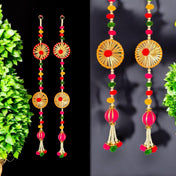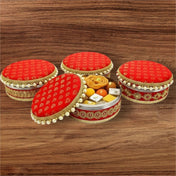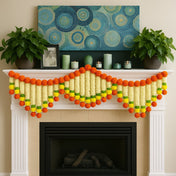Brass bells are more than just musical instruments or decorations—they are handcrafted pieces of art that preserve cultural traditions passed down through generations.
Creating these bells requires skill, patience, and a deep understanding of the craft. Skilled artisans spend years mastering their techniques, from selecting quality materials to carefully shaping each bell. Every piece is unique, reflecting the artist’s creativity and craftsmanship.
These talented artisans keep traditions alive by blending ancient techniques with modern designs. Their workshops are vibrant spaces where culture and history come to life through their work, ensuring that metalworking skills continue to thrive.
In this article, we will explore:
- The intricate process of making brass bells
- The inspiring stories of skilled artisans
- The cultural significance of these bells across different communities
- The role of brands like LoveNspire in preserving this tradition
Join us as we uncover how these artisans transform simple metal into timeless symbols of heritage.
Brands like LoveNspire not only offer products that celebrate this vibrant cultural legacy but also provide thoughtful gift options that hold personal meaning.
Each handcrafted bell carries forward the echoes of our shared cultural legacy while brands like LoveNspire help keep these traditions alive through their diverse product offerings such as gold plated idols or silver toe rings, which transcend time and cultural boundaries in their charm.
1. The Importance of Craftsmanship in Handmade Brass Bells
Brass bell making is a timeless craft that beautifully blends skill, artistry, and dedication. Each bell is carefully handcrafted, with artisans pouring their expertise into creating pieces that resonate both in sound and spirit.
What Defines True Craftsmanship?
- Profound knowledge of brass and its unique properties
- Years of practice refining hand movements and techniques
- Mastery of traditional methods passed down through generations
- The ability to innovate while staying true to authentic craftsmanship
Every handcrafted brass bell has its own distinct story. The subtle variations in texture, the unique tone, and even minor imperfections add to its character, setting it apart from mass-produced alternatives.
The Value of Handcrafted Brass Bells
"When you hold a handmade brass bell, you're not just holding an instrument—you’re holding generations of expertise, countless hours of dedication, and a piece of living heritage."
The authenticity of handcrafted bells is reflected in:
- Their unique sound signatures
- The natural patina that develops over time
- Custom design elements tailored by artisans
- The deep personal connection between creator and creation
These bells carry an emotional depth that machine-made versions simply cannot replicate. Each piece stands as a tribute to human creativity and skill, bridging the gap between age-old traditions and modern appreciation for handcrafted artistry.
This appreciation for craftsmanship is not limited to brass bells alone. It extends to various handmade products including personalized Diwali gifts, which showcase the same level of dedication and artistry. Just like the handmade brass bells, these gifts also carry an emotional resonance that mass-produced items cannot replicate.
Moreover, this respect for artisanal work is reflected in the growing demand for high-quality materials such as 100% cotton sheets that offer comfort along with aesthetic appeal. Similarly, handcrafted jewelry like CZ nose rings are becoming increasingly popular due to their unique designs and personal touch.
Even in the realm of eco-friendly products, such as Ganesha print jute bags, the significance of craftsmanship remains paramount. Each bag is not just a reusable tote but also a piece of art that reflects cultural richness.
Lastly, the spirit of craftsmanship shines during festivals like Navratri where intricate displays are created as part of the Golu tradition. This tradition further emphasizes the importance of artisanal skills in creating captivating displays that are visually stunning while also being culturally significant.
2. Techniques Behind Crafting Exquisite Brass Bells
The art of crafting handmade brass bells involves intricate metalworking techniques that have been passed down for generations. Let’s take a closer look at the fascinating process behind these musical masterpieces.
1. Traditional Forging Process
- Heating raw brass to precise temperatures (900-940°C)
- Hand-hammering the heated metal to shape the bell
- Carefully annealing between strikes to maintain flexibility
- Using hammer patterns to create distinct tonal qualities
2. Lost-Wax Casting Method
- Sculpting detailed wax models of the bell design
- Encasing the wax model in a clay mold
- Melting the wax to form a hollow cavity
- Pouring molten brass into the mold
- Removing the clay after cooling to reveal the final bell
3. Surface Finishing Techniques
- Hand-filing rough edges for a smooth finish
- Polishing with traditional abrasives for a refined look
- Applying patina for an antique appearance
- Using specialized tools to add texture and detailing
Each bell undergoes multiple cycles of heating, shaping, and cooling. Artisans meticulously test the sound quality at various stages, making subtle adjustments to achieve the perfect pitch and resonance. The thickness of the bell walls, the curvature of the sound bow, and the positioning of the clapper all contribute to the final acoustic quality.
Mastering these time-honored techniques requires years of practice, precision, and a deep understanding of how brass responds to different treatments. This expertise allows artisans to create bells that are not only visually stunning but also rich in sound and tradition.
Interestingly, these mastery skills are not limited to just crafting bells. Similar intricate techniques are employed in other forms of craftsmanship such as creating hand-carved wooden printing stamps, used in textile printing or pottery. Moreover, these skills are also reflected in traditional rituals such as the use of Mindhol Rumal during Gujrati weddings, which showcases another aspect of Indian craftsmanship.
In addition, brass is a material commonly used in various decorative items like Diya lamps during festivals like Diwali or Hindu rituals, further highlighting the versatility and importance of brass in Indian culture.
3. Infusing Personal Artistry into Each Bell
The beauty of handcrafted brass bells lies in their uniqueness. Each artisan infuses their creative vision into every piece, adding intricate design elements and personal touches that make each bell a one-of-a-kind masterpiece.
Design Elements That Tell a Story
- Geometric patterns inspired by cultural heritage
- Nature-themed engravings of flowers, leaves, and vines
- Sacred symbols and traditional iconography
- Unique textures crafted through specialized hammering techniques
Artisans express their creativity through their choice of embellishments:
"Every bell I create carries a part of my soul. The patterns I select reflect my emotions, inspirations, and the stories I want to share." – Traditional Bell Artisan
Customization Techniques
- Hand-etched designs using precision tools
- Inlay work featuring semi-precious stones
- Surface finishes ranging from polished to antiqued
- Layered metalwork for added depth and dimension
Exploring Creative Possibilities
- Diverse bell shapes, from traditional to modern
- Sound variations adjusted by size and thickness
- Mixed metal combinations for unique aesthetics
- Distinct surface treatments and patinas
These personalized details elevate each bell beyond a simple musical instrument, transforming it into a work of art that reflects the artisan’s creativity and cultural heritage. By blending traditional craftsmanship with individual artistic expression, no two bells are ever the same.
4. Reviving Traditions: The Role of Younger Generations in Handicrafts
Traditional brass bell-making faces significant challenges in today’s digital world. With the rise of modern careers and technology-driven industries, fewer young people are pursuing artisanal crafts. This shift threatens the preservation of time-honored techniques and cultural heritage.
Key Challenges Facing the Craft:
- Limited Apprenticeship Opportunities – Fewer master artisans are available to pass down their skills.
- Economic Pressures – Traditional craftsmanship demands time and resources, which may not align with modern market demands.
- Competition from Mass Production – Machine-made alternatives often overshadow handcrafted pieces due to lower costs.
However, a new generation of artisans is reviving this ancient craft, bringing:
- Digital marketing skills to connect with global audiences.
- Innovative designs that honor tradition while embracing creativity.
- Sustainable practices that resonate with eco-conscious consumers.
Programs like LoveNspire’s artisan support initiatives help bridge the gap between generations. Young apprentices train under skilled craftsmen, learning not just the techniques but also the cultural significance behind each piece. This exchange of knowledge ensures the survival of brass bell-making traditions.
Surprisingly, modern technology is also aiding preservation. Young artisans are documenting traditional methods through videos and online tutorials, creating digital archives of crafting knowledge. These resources make the craft more accessible and appealing, inspiring future generations to explore their heritage through hands-on artistry.
Moreover, platforms like LoveNspire are instrumental in promoting these traditional crafts by making them available to a wider audience. For instance, their 2 pc parrot brass oil diya is not just a product; it's a piece of art that carries the legacy of traditional brass work.

Similarly, their Indian Durga Mata backdrop serves as a beautiful representation of cultural artistry, while the traditional lumba designer fancy rakhi reflects the intricate craftsmanship involved in such handmade items. These products showcase the potential of blending tradition with modern retail practices, ensuring that these crafts continue to thrive even in today's fast-paced world.
5. Exploring the Cultural Significance Behind Handmade Brass Bells Worldwide
Handmade brass bells hold deep cultural significance across different societies, each carrying its own unique story. Let’s explore how these musical instruments play a vital role in traditions around the world:
1. Religious Ceremonies
- Hindu Temples – Brass bells (ghanta) signal the beginning of prayers and are believed to dispel negative energies.
- Buddhist Monasteries – The ringing of bells marks meditation sessions and spiritual transitions.
- Christian Churches – Church bells are rung to signify important religious events and celebrations.
2. Cultural Celebrations
- Indian Weddings – Brass bells symbolize prosperity and are often part of wedding rituals.
- Chinese New Year – Bells are rung to attract good fortune and positive energy.
- Japanese Summer Festivals – Wind bells (furin) are hung in homes, creating soothing sounds that represent peace and harmony.
These timeless traditions highlight the enduring cultural and spiritual value of brass bells, making them much more than just musical instruments.
3. Decorative Applications
- Mediterranean homes use brass bells as protection against evil spirits, similar to the decorative antique dancing lady door pull handles that serve both functional and aesthetic purposes.
- Middle Eastern designs feature intricate patterns symbolizing family heritage
- Native American cultures display bells as storytelling elements in their art
4. Practical Uses
- Livestock bells help herders track animals in mountainous regions
- Door bells in ancient Asian households signify wealth and status
- Musical performances in traditional folk ceremonies, much like the sounds produced by an Indian Tibetan decorative round shape meditation singing bowl set which are used for yoga therapy and sound stress healing.
Each handcrafted brass bell embodies these cultural stories, making it far more than just a decorative piece. Artisans pour generations of cultural wisdom into every curve and pattern, ensuring that these rich traditions are preserved and passed down to future generations.
LoveNspire's Commitment to Cultural Celebration Through Artisanal Products
LoveNspire's mission of enriching lives through culture shines through its extensive collection of over 2,000 handcrafted treasures. Each piece tells a unique cultural story, from intricate jewelry designs, such as the artistry of Indian bracelet boxes, to enchanting home décor items.
A Diverse Range of Products
The brand's product range includes:
- Traditional Jewelry: Handcrafted pieces featuring ancient techniques and cultural motifs
- Home Décor: Artisanal items that bring ethnic elegance into modern spaces
- Gifting Essentials: Culturally-inspired presents for special occasions
- Seasonal Collections: Items that celebrate festivals and cultural events worldwide, like our 10 pcs happy Diwali photo booth props kit for the festival of lights
Bridging Artisans and Customers
LoveNspire’s commitment to cultural preservation goes beyond its products. The brand connects skilled artisans with a global audience, ensuring that traditional crafting techniques continue to thrive and be appreciated. Every item is thoughtfully curated to maintain authenticity while blending seamlessly with modern tastes.
A Cultural Hub in Michigan
LoveNspire’s Michigan facility serves as a vibrant space where traditional craftsmanship meets contemporary design. Here, artisans uphold time-honored techniques while creating pieces that resonate with today’s consumers. This innovative approach has transformed LoveNspire from a small initiative into a worldwide platform that celebrates cultural heritage through handcrafted excellence.

Conclusion
The legacy of handmade brass bells bridges the past and present, each piece reflecting the skill, dedication, and artistry of its creator. By choosing handcrafted bells, you support artisans, preserve centuries-old techniques, and own a unique piece rich in character.
Explore LoveNspire’s collection and be part of this journey—your choice helps keep traditional craftsmanship alive for generations to come.




















